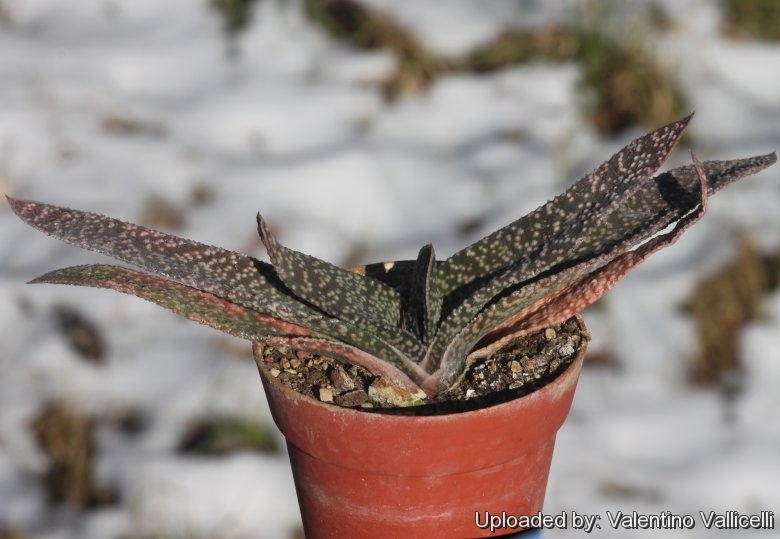Donate now to support the LLIFLE projects.
Your support is critical to our success.
Your support is critical to our success.
Accepted Scientific Name: Gasteria carinata var. verrucosa (Mill.) van Jaarsv.
Aloe 29(1): 15 (1992)

Aloe verrucula (Gasteria carinata var. verrucosa) Photo by: Valentino Vallicelli
Synonyms:
- Gasteria carinata var. verrucosa (Mill.) van Jaarsv.
- Aloe acuminata Lamarck
- Aloe carinata DC.
- Aloe racemosa Lamarck
- Aloe verrucosa Mill.
- Aloe verrucula Medik.
- Gasteria verrucosa (Mill.) Duval
See all synonyms of Gasteria carinata
back
Accepted name in llifle Database:Gasteria carinata (Mill.) Duval
Pl. Succ. Horto Alencon. . 6 1809.
Synonymy: 42
- Gasteria carinata (Mill.) Duval
- Aloe carinata Mill.
- Aloe carinata Ker Gawl.
- Aloe carinata var. laevior Salm-Dyck
- Aloe carinata var. subglabra Haw.
- Aloe lingua var. multifaria Haw.
- Aloe linguiformis DC.
- Aloe obscura var. truncata Salm-Dyck
- Aloe pseudoangulata Salm-Dyck
- Aloe pusilla Schult. & Schult.f.
- Aloe tristicha Medik.
- Gasteria angulata (Haw.) Duval
- Aloe angulata Willd.
- Aloe lingua var. angulata Haw.
- Gasteria angulata (Willd.) Haw.
- Gasteria disticha var. angulata (Willd.) Baker
- Gasteria angulata var. truncata (Willd.) A.Berger
- Aloe angulata var. truncata Willd.
- Gasteria bijliae Poelln.
- Gasteria carinata var. falcata A.Berger
- Gasteria carinata var. latifolia A.Berger
- Gasteria carinata var. parva (Haw.) Baker
- Gasteria parva Haw.
- Gasteria carinata var. strigata (Haw.) Baker
- Gasteria strigata Haw.
- Gasteria carinata f. variegata hort.
- Gasteria excavata (Willd.) Haw.
- Aloe excavata Willd.
- Gasteria laetepunctata Haw.
- Aloe laetepunctata (Haw.) Schult. & Schult.f.
- Gasteria laevis (Salm-Dyck) Haw.
- Aloe laevis Salm-Dyck
- Gasteria pallescens Baker
- Gasteria parvifolia Baker
- Gasteria porphyrophylla Baker
- Gasteria subcarinata (Salm-Dyck) Haw.
- Aloe subcarinata Salm-Dyck
- Gasteria sulcata (Salm-Dyck) Haw.
- Aloe sulcata Salm-Dyck
- Gasteria trigona var. kewensis A.Berger
- Gasteria undata Haw.
- Aloe undata Schult. & Schult.f.
Gasteria carinata var. glabra (Salm-Dyck) van Jaarsv.
Cact. Succ. J. (Los Angeles) 70: 70 1998
Synonymy: 7
- Gasteria carinata var. glabra (Salm-Dyck) van Jaarsv.
- Aloe glabra (Haw.) Salm-Dyck
- Gasteria carinata f. glabra (Salm-Dyck) van Jaarsv.
- Gasteria glabra Haw.
- Gasteria carinata var. schweickerdtiana (Poelln.) hort.
- Gasteria schweickerdtiana Poelln.
- Gasteria patentissima Poelln.
Gasteria carinata var. retusa van Jaarsv.
Aloe 29: 15 1992.
Synonymy: 2
- Gasteria carinata var. retusa van Jaarsv.
- Gasteria retusa (van Jaarsv.) van Jaarsv.
Gasteria carinata var. thunbergii (N.E.Br.) van Jaarsv.
Cact. Succ. J. (Los Angeles) 70: 70 1998.
Synonymy: 3
- Gasteria carinata var. thunbergii (N.E.Br.) van Jaarsv.
- Aloe disticha Thunb.
- Gasteria thunbergii N.E.Br.
Gasteria carinata var. verrucosa (Mill.) van Jaarsv.
Aloe 29(1): 15 (1992)
Synonymy: 31
- Gasteria carinata var. verrucosa (Mill.) van Jaarsv.
- Aloe acuminata Lamarck
- Aloe carinata DC.
- Aloe racemosa Lamarck
- Aloe verrucosa Mill.
- Aloe verrucula Medik.
- Gasteria verrucosa (Mill.) Duval
- Gasteria intermedia var. laevior Haw.
- Gasteria intermedia var. longior Haw.
- Gasteria radulosa Baker
- Gasteria repens Haw.
- Aloe repens Schult. & Schult.f.
- Gasteria subverrucosa (Salm-Dyck) Haw.
- Aloe subverrucosa Salm-Dyck
- Gasteria subverrucosa var. grandipunctata (Salm-Dyck) Haw.
- Aloe subverrucosa var. grandipunctata Salm-Dyck
- Gasteria subverrucosa var. marginata Baker
- Gasteria subverrucosa var. parvipunctata (Salm-Dyck) Haw.
- Aloe subverrucosa var. parvipunctata Salm-Dyck
- Gasteria verrucosa var. asperrima (Salm-Dyck) Poelln.
- Aloe intermedia var. asperrima Salm-Dyck
- Gasteria intermedia var. asperrima Haw.
- Gasteria verrucosa var. intermedia (Haw.) Baker
- Aloe intermedia Haw.
- Gasteria intermedia (Haw.) Haw.
- Gasteria verrucosa var. latifolia (Salm-Dyck) Haw.
- Aloe verrucosa var. latifolia Salm-Dyck
- Gasteria verrucosa var. scaberrima (Salm-Dyck) Baker
- Aloe scaberrima Salm-Dyck
- Gasteria verrucosa var. striata (Salm-Dyck) Poelln.
- Aloe verrucosa var. striata Salm-Dyck
back
| Your Actions | |
|---|---|
| Back to Aloe index | |
| Back to Aloaceae index | |
 |
Back to Succulents Encyclopedia index |








